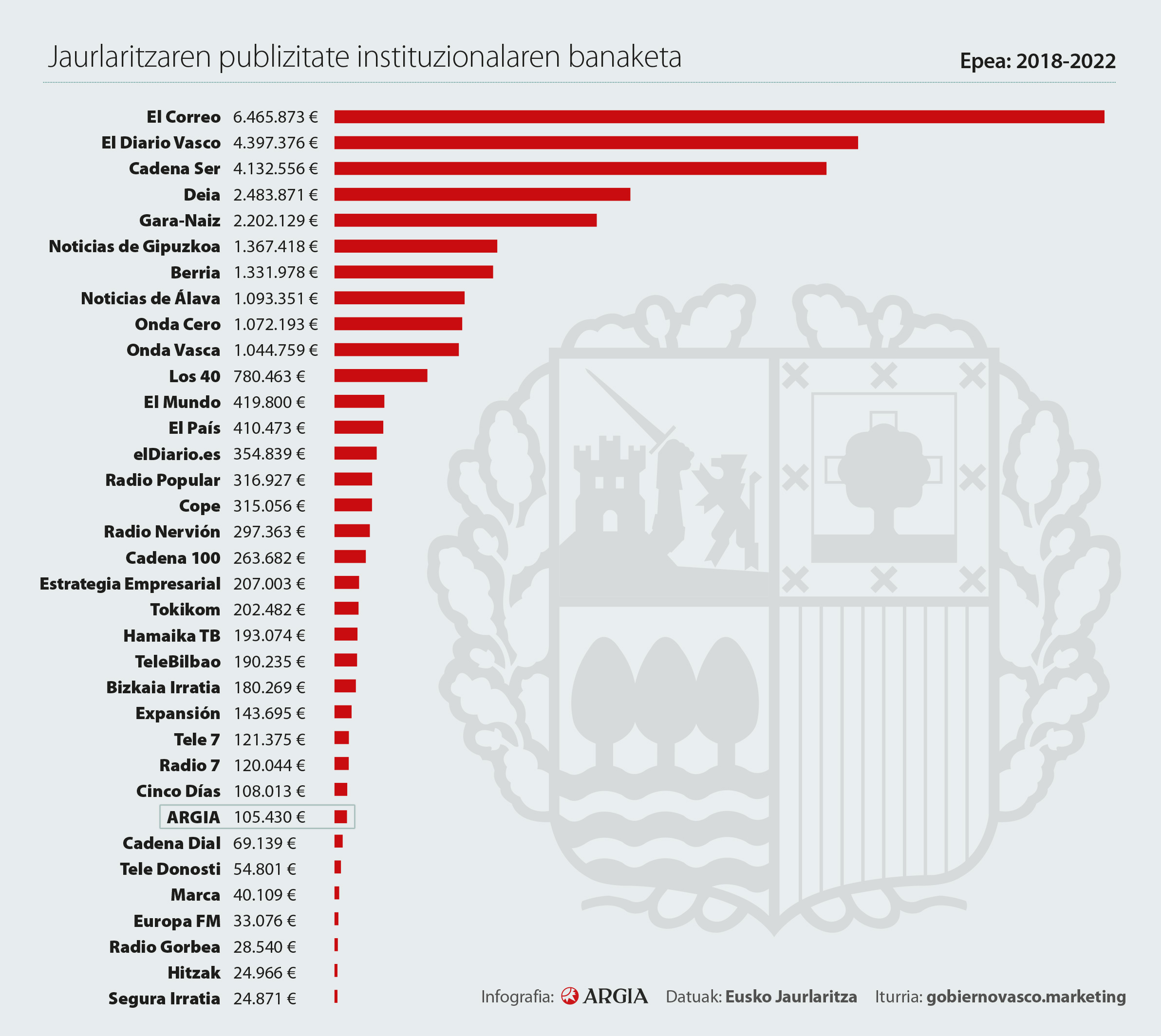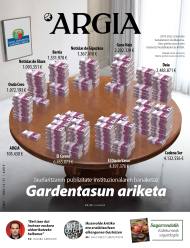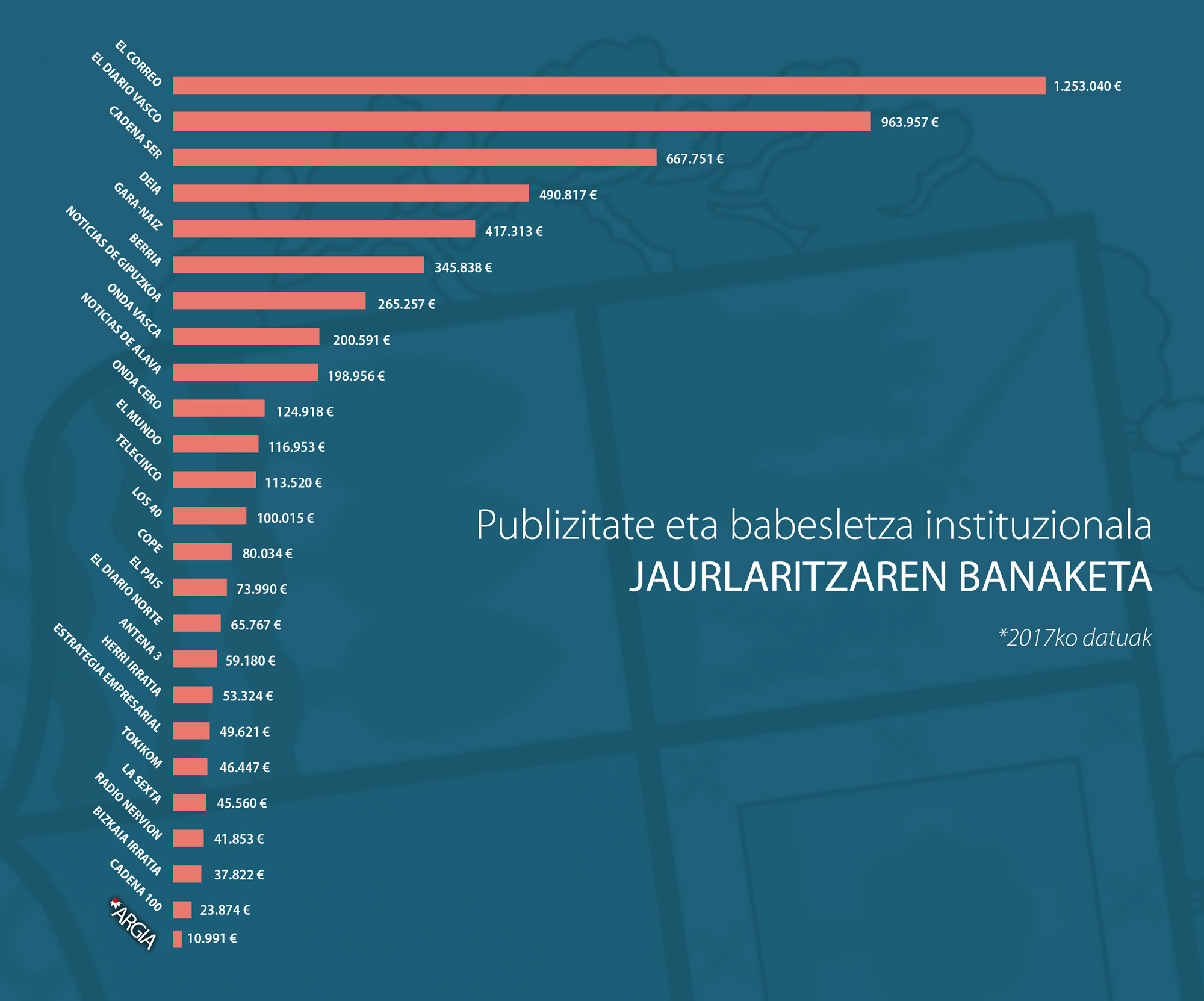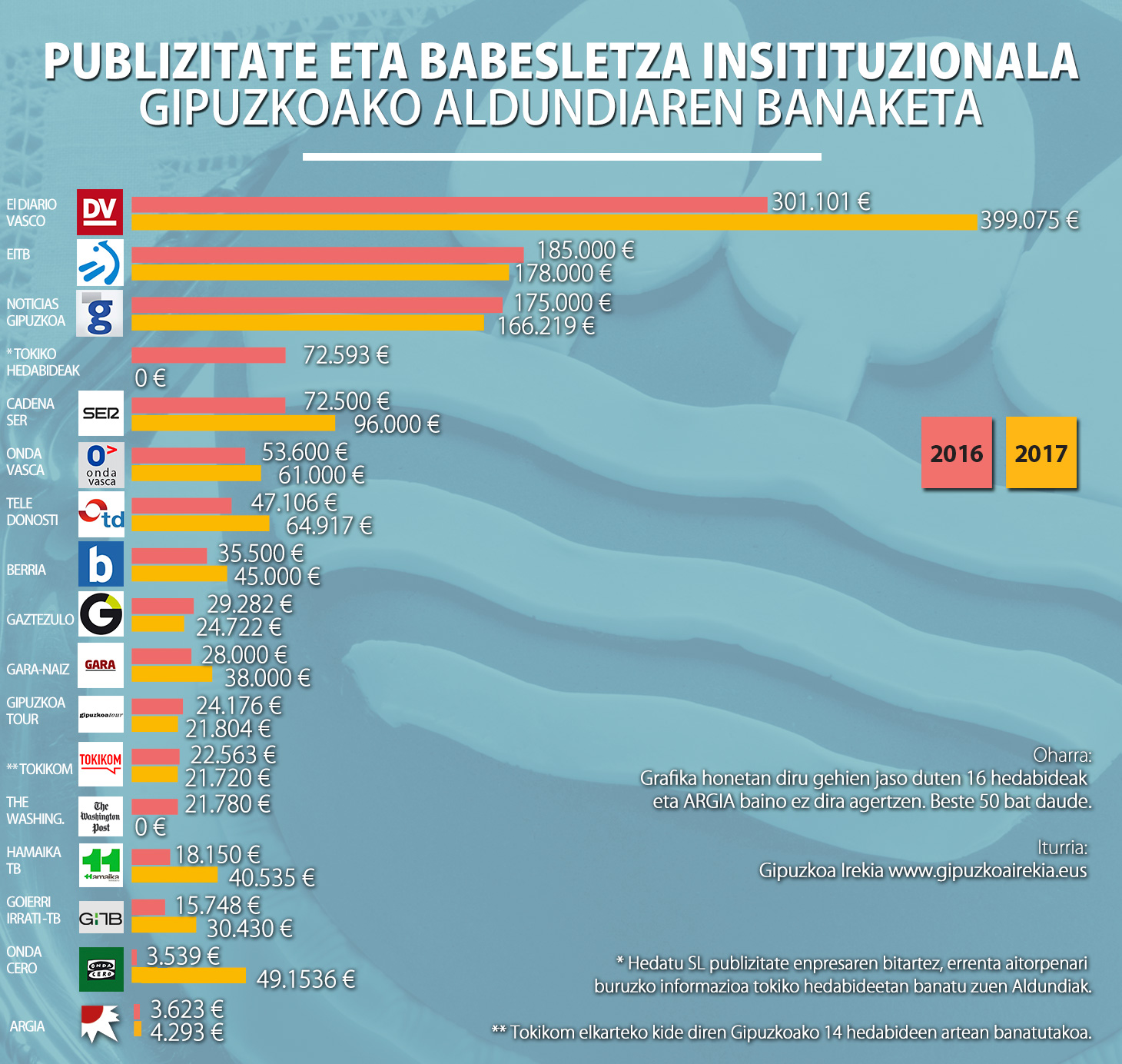For media power to remain right-wing and Castilian speaking
- Every year, the public institutions of the Basque Country distribute millions among the media in exchange for spreading institutional advertising or supporting media initiatives. In general, the lack of transparency of these public data makes it difficult to take possession of the full photograph, but fortunately, thanks to a new computer tool, we have analysed the distribution of the government over the past five years. The result is typical: 80% of the money for the media of Vocento, Noticias and Hurry, 93% for those mainly Spanish, 7% for Euskera and 0.3% for ARGIA.

Power over media has always been the obsession of most governments. One way of achieving this objective is institutional advertising. The opacity and arbitrariness of these payments to the media with public money dominate the Western countries, and in the Basque Country we are also no exception.
As regards Álava, Bizkaia and Gipuzkoa, we have on many occasions denounced on these pages how the government, the three deputies and the city councils use institutional advertising to maintain media power.
The transfer of the millions used for advertising to the media is a very sensitive issue, particularly if transparency is not guaranteed. In recent years, we have repeatedly denounced that the government awards a number of media, mainly right-wing erdaldunes dependent on international banks and investment funds, headed by Vocento. And, of course, this unequal distribution punishes other means, including independent ones. One of the most prominent cases is LUZ.
In 2017 we published this distribution in ARGIA. It was a complicated and laborious job, because the Government disseminates media procurement in very opaque and distant formats, despite public and sensitive information. This has been denounced on several occasions by the parliamentary opposition – EH Bildu and Elkarrekin Podemos – and has called for action. Now, fortunately, thanks to a tool developed by the expert activist for transparency in the public sector, Jaime Gómez-Obregón, we have more detailed information about the advertising campaigns from 2018 to 2022 years and their payments.
It may be more, not less,
Gómez-Obregón gobiernovasco.marketing has made available on the website memories of the last five years on the advertising distribution of the Government. The results are shown in the graph of this report [more information in the interview we have published to Gómez-Obregón with this report]. At ARGIA we have compared some data and, in general, we have seen that the money raised by the main media is even more, but, in any case, the Gómez-Obregón tool ensures that the amounts perceived by the media are safe, that is, that in some cases they may be higher, but in no case lower. The media have collected at least the figures in the graphs. But above all this tool allows us to see the full picture of the media ecosystem that the government promotes through advertising.
Half of the cake has been placed in El Correo and its free accessories for three media, almost half (665) of the 1,351 advertising campaigns carried out by the government between 2018 and
2022 and has paid almost six and a half million euros. The Diario Vasco, also from Vocento, including the DVBus of the Donostiarras buses it manages, has received 517 campaigns and almost four and a half million euros. For the chain Ser in Hurry 388 campaigns and more than 4 million euros. In total, these three major media have received the same amount as the other media.

By Corporations, the media of the public group EITB have received the most money, about 15 million. The Vocento-Cope-Cadena 100 group follows, with a strategic alliance signed: About 11.5 million. It is followed by Deia, News from Gipuzkoa, News from Alava, Onda Vasca and Herri Irratia, which have received more than six million euros. Fourthly, the Hurry Group: El País, Cadena Ser, Los 40 y Cadena Dial. These have raised over EUR 5 and a half million. The next would be the Gara Naiz group, but far from the amounts received by the previous ones, with two million euros in five years.
When ARGIA again rejected the
inappropriate advertising distribution of 2017, we said: “The main pillar and economic sustenance of ARGIA are the thousands of people who form our community. These citizens, like ARGIA, pay taxes here, but the government’s advertising distribution discriminates against them.” Six years have passed and we shall repeat the same words, as the data have shown us.
ARGIA readers have only known in the last five years 69 government advertising campaigns. We have received about EUR 100,000 in return. Expansion, Tele 7, Radio 7, Five Days, TeleBilbao and Bizkaia Irratia below the means, to name a few. The Government has granted El Correo, in a single advertising campaign, the same amount of money for ARGIA for five years: EUR 103.203 in exchange for expanding the Basque Green Deal to “raise awareness of the importance of achieving the European climate change targets by 2030”.
The Basque Government encourages the Basques to report in Spanish, with the exception of the bilingual public group EITB, while the Basque Government in the five-year period 2018-2022 has ceded 93% of its money through advertising and sponsorship to the
media that work in Spanish or mainly in Spanish. For the Basque media 7%
restante.En, the only national newspaper in Basque Country Berria has received almost two-thirds: EUR 1,331,000. Local media have received EUR 200,000, near Hamaika Telebista. Some 180,000 euros have been for Bizkaia Irratia. As ARGIA said, EUR 105,430.

The government's commitment to the Spanish media is evident. For example, the Deia newspaper has received more money than the sum of all the media in Basque. The Ser Chain is twice the total in Basque and only El Correo is more than triple.
The commitment to Spanish is not just that. The government has also committed itself to the Spanish-language channels within the public EITB. For example, Euskadi Irratia and Gaztea allocate 2,133,000 euros to the broadcasting stations and Radio Euskadi and Radio Vitoria 3,125,000 euros, one million more.
Another example: the government has invested almost as much in Basque media on social networks dependent on multinationals (Twitter, Google, Facebook…).

The media in Basque are “subsidized”. Confusion
is sometimes created and it should be clarified. In this report we are talking about the institutional publicity that the government places on the media. We are not talking about the subsidy received by the media in Basque for promoting Basque. "But the Basque media also gets money," we've heard, as if they compensate each other. And it's not. In this sense, it is attributed to the media in Basque, at some point in a malicious way, the existence of “swollen public money” for the money that institutions receive annually in contrast to the public function of the media in the promotion of the Basque. However, through institutional advertising much more money is distributed among the Spanish-language media than through grants in Euskera, without a transparent criterion.
We will explain this by an example. ARGIA received in 2022 526,646 euros to boost its work in the normalization of the Basque country. If we add to this the subsidy granted by Hazitek of EUR 10,510, and the EUR 24,097 that we received from the government during that year for institutional advertising and the EUR 9,135 from the Member of Gipuzkoa, the result is about EUR 570.000. The Diario Vasco, for its part, received €883,795 in 2022 in institutional advertising. To this must be added the money that the Provincial Council of Gipuzkoa grants annually to the Spanish media, including El Diario Vasco, by writing articles in Basque (399,075 euros in 2017) and the City of San Sebastian (99.979 euros in 2021), among others. But not only that, in the name of the damage caused by the COVID-19 pandemic in 2021 and 2022, the government distributed some media extraordinary aid: five million in 2021 and six million in 2022. The media in Basque were almost completely excluded from this distribution. In 2021, 93.4% of the money went to Spanish and 6.6% to Basque. More crude example: The Vocento group (El Correo y El Diario Vasco) was given 5,015,695 euros and ARGIA none.
Therefore, all the media receive public money, but the Basque people, besides having to justify everything to the last cent, try to put the false “burden of being subsidized”. On the contrary, in addition to the fact that the Spanish media receive much more public money in general, the institutions are the main support of the economic viability of these media closest to power, which implies customer relations with power, as they have demonstrated on several occasions.
The law that regulates the use of institutional advertising in Álava, Bizkaia and
Gipuzkoa, along with the vago of the law, dates from 2010, when he was lehendakari Patxi López. It goes like this. "Undoubtedly, as it is an activity with social impact and is a very sensitive content, it is necessary to have a law that clearly establishes the area in which it will develop [...] that guarantees the access of all citizens to information".
But this law does not specify one of the main points expected of such a law: the criteria for distributing the institutional advertising cake among the media. The Basque Law only provides: The "most advantageous economic offer" (Article 9) will be chosen and the "effectiveness and efficiency of the campaign" will be prioritised. I mean, they're very blurry criteria.
Moreover, the law does not oblige that distribution to be verified by an independent entity and the only exercise of transparency is the PDF that the Government should submit annually to Parliament. Moreover, these documents have been highly criticized for their number of errors, for the lack of unified criteria, for the poor quality of the data, for the lack of valuation between the money invested in campaigns and their effectiveness... They distribute millions of public euros according to fuzzy criteria, without independent control and in a format that does not guarantee transparency and general analysis by contributing datos.Frente to the criticisms contained in this partial distribution, the Basque Government has on several occasions pointed out the "scope of the media" as a
general and unique criterion. And for this, although it is not collected anywhere, they take into account as a reference the counts made by CIES. This was demonstrated, for example, to justify the unequal distribution of "extraordinary aid" to certain media "to mitigate the effects of COVID-19".
Reach yes, but only when interested Therefore, the
audience is the criterion for distributing money. But is that always the case? We will analyze what the call received. The ideologically closest medium to the one that governs is the fourth half that received the most money between 2018 and 2022: two and a half million euros.
Every year Deia receives more money from the government through advertising: EUR 373,026 in 2018 and EUR 565,795 in 2022. That is, an increase of 34% in five years. Few media have enjoyed this economic increase.
As for enlargement, the trend is opposite. According to CIES measurements used by the government to rank media coverage, Deia lost 38% of paper readers between 2018 and 2022. In 2018 it had 79,000 readers and in 2022 it had 49,000. For example, in 2022 CIES awarded ARGIA 52,000 readers in the CAV. Despite similar data, last year Deia received EUR 565,795 from government advertising and ARGIA 24.097. The rise on the Internet would not justify this rise, which is widespread in all media.
And let us not forget: This newspaper, which the Basque Government’s Minister for Culture and Linguistic Policy, Bingen Zupiria, ran from 2012 to 2016, has been in the midst of an economic crisis. In recent years, the Deia Workers Committee has repeatedly denounced the “unbearable situation” they live in due to wage cuts and redundancies.
In addition
to being difficult to quantify the real scope of the media with the arrival of the Internet to reinforce the status quo, considering the scope as a single criterion generates a vicious circle. Devoting much more money to the media with more readers/listeners/viewers than to smaller ones, it will remain large and marginal. Without forgetting that year after year the data show that this criterion contributes to perpetuate the hegemony of Castilian to the detriment of the Basque Country.
Seeing that the general trend of distribution is repeated year after year, what we were already seeing is clearer: through the unfair distribution of advertising, the Basque Government determines year after year the media ecosystem according to its interests.
And so, what?Every change
starts in itself, and on this issue the media also have a lot of responsibility, because almost nobody talks about this issue and nobody publishes their data. Because some are afraid to lose the little money they can get, and others, of course, because they benefit from opacity and because they have participation. Without making the institutions unaccountable, the media should perhaps be an example, more transparent and publish the revenue of the public sector, even more so at a time when the unreasonable dependence on political power is greatly impaired by the credibility of the main media.
Consideration of scope as a single criterion is incompatible with the diversity that every public institution should promote. Thus, the right to information is being delegated to the market and to the "will" of capital. You only have to turn on television to see what kind of cultural and political "diversity" the market offers without public intervention.
Would it not be interesting to set ceilings on quantities for large groups? And consider other meters besides the scope to balance advertising? For example, by introducing social variables such as the degree of transparency of the media, the promotion of cooperativism, the conditions of workers, the degree of independence of the media, the guarantee of deontological accounts... Or is it normal for us to award at the same level the media owned by the multinationals and the media in which the workers are the owners?
In feminist policies, norms of positive discrimination prevail to mitigate historical differences between privileged and discriminated. Who pays the most in fair tax policies for a fairer distribution. But on the subject of institutional advertising the opposite is true. In fact, the government allocates more money to those who have the most money. So nothing changes.
*Interview by Jaime Gómez-Obregón, which has expanded and structured government data:
Zein dira publizitate bidez diru publiko gehien jasotzen duten hedabideak? Arabako Aldundiak publizitatea zein mediotan inbertitzen duen aztertu du Hala Bedik. El Correo de Álava da jaun eta jabe, publizitatearen %31,8a jasotzen baitu; nagusiki euskaraz aritzen diren... [+]
Espainiako Gardentasun Kontseiluak zortzi ministeriori iragarkien datuak publiko egin behar dituztela exijitu ostean, salaketa jarri dute Auzitegi Nazionalean erabakia ez betetzeko.
Hedabide euskaldunak biltzen dituen Hekimen elkarteak bilera eskatu dio Gipuzkoako Foru Aldundiari, erakunde horrek iragarritako publizitate instituzionalaren beherakada aztertzeko. 2015eko aurrekontuarekin alderatuta, erdira jaitsiko du euskarazko hedabideetako publizitatea... [+]






















